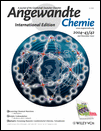Calibrated Calculation of Polyalanine Fractional Helicities from Circular Dichroism Ellipticities†
This research was supported by the NSF CHE-0131250 and the NIH GM 13453 (S.M.W.).
Graphical Abstract
Maximally helical polyalanines, 9 to 24 residues in length, are used to calibrate the assignment of fractional helicity (FH) from circular dichroism ellipticities. Water-solubilizing, helix-stabilizing N- and C-caps induce FHs>0.9 in core polyalanine regions. Linear length regressions of peptide molar ellipticities (blue-green curves) yield slopes (red arrows) that define molar per-residue ellipticities of a fully helical alanine residue (red curve).





